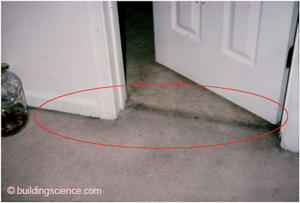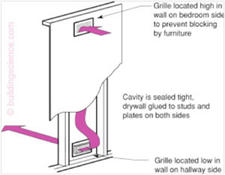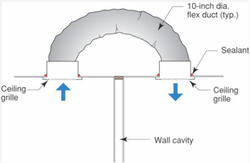This article addresses the issue of undercutting bedroom doors to provide return airflow from bedrooms resulting in risks such as insufficient airflow, pressure imbalance, energy-inefficient loss of conditioned air, condensation within the wall, and moisture durability issues. Corrective measures are also suggested.

Carpet filters air from a pressurized bedroom
Transfer grille examples to alleviate pressure differences
Jump duct transfer grille to alleviate pressure differences
Issue
Undercutting bedroom doors to provide return airflow from bedrooms.
Description of Implementation Error
Conditioned air supply registers are located in the bedrooms, and the return to the conditioning equipment is often located in a hallway or on another floor. This means the bedrooms, hallways, and stairwells are part of the return pathway for air movement back to the air conditioning system.
Risks
This approach is acceptable but Building America research has demonstrated that the common technique of undercutting bedroom doors does not provide for enough airflow and there is often a pressure imbalance resulting in a positively pressured bedroom. In addition to an energy-inefficient loss of conditioned air to the enclosure or outdoors, warm moist air may be pushed into a cold enclosure possible allowing for condensation within the wall and resulting moisture durability issues. Door undercuts are often obstructed by carpets further reducing return pathways. Carpets will filter the air and remove all the candle soot and other airborne particulate, as it is forced under the bedroom door due to a high pressure difference. Also associated with high pressure differences on the return pathway is an increased air leakage rate (ACH) from the building. The increased air leakage from the building can result in a 10% to 20% increase in energy required for space conditioning.
Required Corrections
The solution to this problem is to provide pressure relief between the bedroom and hallway either with through-wall transfer grilles or jump ducts through the attic.1 Transfer grilles are preferred to keep the air movement inside the conditioned space in the case of ventilated attics. Ducts should be sized to maintain less than a 3Pa pressure difference across a closed door.2
Footnotes



